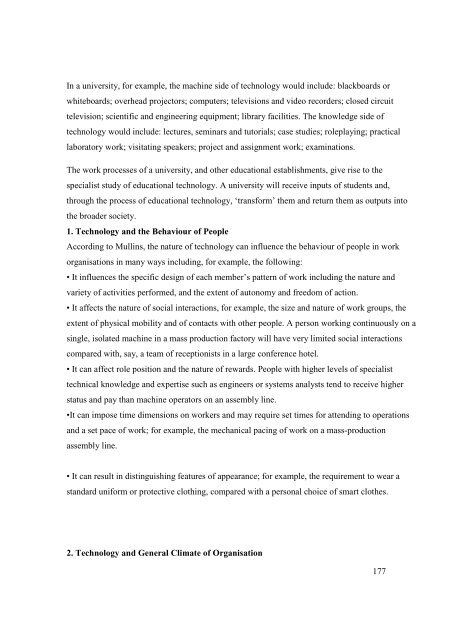HCM 433 MANGEMENT AND ORGANIZATIONAL BEHAVIOUR.pdf
HCM 433 MANGEMENT AND ORGANIZATIONAL BEHAVIOUR.pdf
HCM 433 MANGEMENT AND ORGANIZATIONAL BEHAVIOUR.pdf
You also want an ePaper? Increase the reach of your titles
YUMPU automatically turns print PDFs into web optimized ePapers that Google loves.
In a university, for example, the machine side of technology would include: blackboards or<br />
whiteboards; overhead projectors; computers; televisions and video recorders; closed circuit<br />
television; scientific and engineering equipment; library facilities. The knowledge side of<br />
technology would include: lectures, seminars and tutorials; case studies; roleplaying; practical<br />
laboratory work; visitating speakers; project and assignment work; examinations.<br />
The work processes of a university, and other educational establishments, give rise to the<br />
specialist study of educational technology. A university will receive inputs of students and,<br />
through the process of educational technology, ‘transform’ them and return them as outputs into<br />
the broader society.<br />
1. Technology and the Behaviour of People<br />
According to Mullins, the nature of technology can influence the behaviour of people in work<br />
organisations in many ways including, for example, the following:<br />
• It influences the specific design of each member’s pattern of work including the nature and<br />
variety of activities performed, and the extent of autonomy and freedom of action.<br />
• It affects the nature of social interactions, for example, the size and nature of work groups, the<br />
extent of physical mobility and of contacts with other people. A person working continuously on a<br />
single, isolated machine in a mass production factory will have very limited social interactions<br />
compared with, say, a team of receptionists in a large conference hotel.<br />
• It can affect role position and the nature of rewards. People with higher levels of specialist<br />
technical knowledge and expertise such as engineers or systems analysts tend to receive higher<br />
status and pay than machine operators on an assembly line.<br />
•It can impose time dimensions on workers and may require set times for attending to operations<br />
and a set pace of work; for example, the mechanical pacing of work on a mass-production<br />
assembly line.<br />
• It can result in distinguishing features of appearance; for example, the requirement to wear a<br />
standard uniform or protective clothing, compared with a personal choice of smart clothes.<br />
2. Technology and General Climate of Organisation<br />
177
















